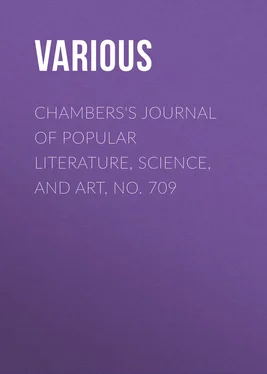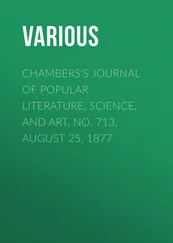Various - Chambers's Journal of Popular Literature, Science, and Art, No. 709
Здесь есть возможность читать онлайн «Various - Chambers's Journal of Popular Literature, Science, and Art, No. 709» — ознакомительный отрывок электронной книги совершенно бесплатно, а после прочтения отрывка купить полную версию. В некоторых случаях можно слушать аудио, скачать через торрент в формате fb2 и присутствует краткое содержание. Издательство: Иностранный паблик, Жанр: periodic, foreign_edu, на английском языке. Описание произведения, (предисловие) а так же отзывы посетителей доступны на портале библиотеки ЛибКат.
- Название:Chambers's Journal of Popular Literature, Science, and Art, No. 709
- Автор:
- Издательство:Иностранный паблик
- Жанр:
- Год:неизвестен
- ISBN:нет данных
- Рейтинг книги:4 / 5. Голосов: 1
-
Избранное:Добавить в избранное
- Отзывы:
-
Ваша оценка:
- 80
- 1
- 2
- 3
- 4
- 5
Chambers's Journal of Popular Literature, Science, and Art, No. 709: краткое содержание, описание и аннотация
Предлагаем к чтению аннотацию, описание, краткое содержание или предисловие (зависит от того, что написал сам автор книги «Chambers's Journal of Popular Literature, Science, and Art, No. 709»). Если вы не нашли необходимую информацию о книге — напишите в комментариях, мы постараемся отыскать её.
Chambers's Journal of Popular Literature, Science, and Art, No. 709 — читать онлайн ознакомительный отрывок
Ниже представлен текст книги, разбитый по страницам. Система сохранения места последней прочитанной страницы, позволяет с удобством читать онлайн бесплатно книгу «Chambers's Journal of Popular Literature, Science, and Art, No. 709», без необходимости каждый раз заново искать на чём Вы остановились. Поставьте закладку, и сможете в любой момент перейти на страницу, на которой закончили чтение.
Интервал:
Закладка:
Above, on the right, is the 'Shoulder,' a narrow projection about twenty yards long, and two or three wide, on which breakfast is to be eaten and preparations made for the final climb. To reach this 'Shoulder' appears a sufficient task from where we are; beyond it rises a smooth perpendicular cone, without flaw or crack, mid air, apparently impossible. Yet as we bend back our heads and say so, out of one side far up, springs a small figure; and the word 'impossible' is wiped out of our dictionaries when we behold that a 'black man and a brother' has essayed the task. Up to the 'Shoulder' it is all hands and feet; beyond that there is nothing for it but rope. Viewed from a distance, the 'Shoulder' forms the knees of the sitting figure which the mountain is said to resemble. From many points the resemblance to the statue of Her Majesty at the London Royal Exchange is ludicrously exact.
When the top of the grass slope is reached, there is a narrow band of turf, dotted with half-a-dozen scrub bushes of a foot or little more high. This band leads off horizontally to the right, and is the only possible way to the 'Shoulder.' A very bad way indeed it is. From below it looks nothing but a strip of green ribbon stretched across the middle of a rocky face, black and green and slimy as ever earth, air, and water put together have concocted to puzzle mountaineers. In truth it is little better than it looks. There are toe-holes to stick your boots into as you walk with your face to the wall; and here and there a shrub to let you feel something between your fingers, besides a bunch of dead damp grass to save you from eternity. The whole passage is oozing with sludge and water, very slippery, and the grass looks utterly rotten and unreliable.
This track, which is about one hundred yards in length, lands you a little below the 'Shoulder;' then a dozen yards' stiff steep climb and you stand upon it – perhaps sit at first – for a yard farther on across it is space, sheer awful space, which to look down till you have got your breath is neither wise nor pleasant. You soon get used to the feeling; but it is a little startling just at first to find that this promised landing-place where breakfast is to be served ends in nothing, just three feet beyond the baskets that contain the provender. When you have got your breath, the first thing to look at is the great bare cone immediately above and the dangling rope up which your road must lie. Your eye takes it all in at a glance, and that first glance is not promising. But breakfast puts a better construction on the onward journey; and by the time we have made acquaintance with the Oxford sausages and Australian sheep's tongues, we begin to scramble about quite merrily, and doff boots, coats, and hats for the task with as jaunty a grace as did my Lord Russell on Tower Hill.
The summit of Pieter Both is a cone of sugar-loaf form, compressed at the sides, that nearest the 'Shoulder' having a slight bulge, without which the ascent would be certainly impracticable. From the 'Shoulder,' which is covered with short grass and wind-scarred scrub, a ridge some three yards wide runs up to the foot of the 'Ladder Rock.' This ridge, which narrows as it goes up, is composed of rock-fractures firmly cemented together, and is to all appearance a great buttress supporting the cone. Up this you climb, hands and knees, without requiring a rope. The buttress comes to an abrupt end at the foot of a huge cube of rock, flat-sided and perpendicular, which stands bolt upright, and bars all further climbing without mechanical aid.
This is the 'Ladder Rock,' and is between fifty and sixty feet in absolute perpendicular height, its breadth being less than twenty feet. Running down its centre is a crack, without which the difficulty of climbing it would have been greatly aggravated, if not insurmountable. Against the face of the 'Ladder Rock' hangs a rope, the end disappearing over the upper edge where it has been made fast; the climb up it being made easier by a rough rope-ladder, which takes you up some dozen feet, to where the crack is sufficiently wide to admit your toes; that reached, grasping the rope with every one of your ten fingers, and squeezing as many of your toes into the crevice as you can, you must trust to your muscles and swing yourself up. The top of this rock reached, you are glad to sit or lie down upon a second ridge like the lower one, but much steeper and narrower; so narrow that in climbing up it, still with the rope tightly grasped, you sit astride it, your legs dangling over the sides, where it is better not to let your eyes follow unless the head that owns them is of the steadiest. This ridge has been christened 'The Saddle,' and is made up of broken rock cemented together with lava. Here and there are tufts of grass, with bosses of the silver-leaved 'everlastings,' wind-torn and ragged, and other plants. The 'everlastings' shew brightly against the cold gray rocks, and tempt many of the party to pluck them to adorn their hats when they get them; which just now is somewhat doubtful, as the slightest slip may be fatal. This dreadful 'Saddle' is said to have once vanquished two aspirants; one of them, conscious that he had 'lost his head,' lay flat along the ridge, allowing the man who came to his rescue to climb over his body, a ticklish bit of mid-aërial gymnastics, which happily came off successfully.
The 'Saddle' rises at a steep angle, say the steep roof of a house, and ends at another 'facer;' a huge rounded rock perhaps ten feet high standing straight up across the way, the way now having narrowed to a blunt-knife edge. This is the 'Saddle Rock,' and is the nastiest-looking and most dangerous place in the ascent. The 'Saddle Rock' must either be swarmed up or circumvented by stretching round its left side; for both experiments a rope is needed, and both are a trifle delicate. This time the rope went round; and the thread which disappeared past the smooth slippery face, out over the ghastly precipice, that fell down sheer into Pamplemousses, was not inviting. To get round you have to sidle up to the base of the rock, holding the tightly stretched rope level with your head, and push on your feet inch by inch till your toes rest on the outermost knob of rock. You must be quite sure that their hold is good before you slip your hands round the corner, letting your head and shoulders follow until you can make out a little branch as thick as your umbrella, and four inches long, which sticks out of a cranny, and is within reach of a long straddle. The awkward part of this is that in looking for the branch you are obliged to look down . It is the first look-down absolutely necessary, and it is one not easily forgotten. To the writer it had a strange fascination. The actual peril of the position; the necessity of coolness in head and eye; the uncertainty how far this could be relied upon, was so startling, so vivid when the actual time came, as to force a feeling of absolute security upon the mind! Never did he feel more certain of his own powers than when hanging like a spread-eagle against the face of that rock twenty-six hundred feet above the plains.
It is a good stretch, but does not require very long legs to do it. One toe, no more, the right one on a knob of rock; the other foot feeling for those four inches of scrub wood; both hands overhead grasping the rope; and the strangest bird's-eye view between one's legs that featherless biped could wish for. It did not do to look too long. Another pull up is in front, along a ridge like the previous two, but narrower again, which runs up to the Neck, the rope your companion all the way; and then you can at last sit down in perfect safety. This is the 'Neck,' which the aneroid gave as three hundred and forty feet above the 'Shoulder.' It forms an irregular plateau partly round the 'Head,' some six or eight feet broad, and quite flat. On it is a carpet of rough grass and 'everlastings,' protected from the wind and rain by the overhanging mass of rock, which is the 'Head,' formed of irregularly shaped rock, forty feet in height, nearly round, and which contains what there is of the brains of Pieter Both.
Читать дальшеИнтервал:
Закладка:
Похожие книги на «Chambers's Journal of Popular Literature, Science, and Art, No. 709»
Представляем Вашему вниманию похожие книги на «Chambers's Journal of Popular Literature, Science, and Art, No. 709» списком для выбора. Мы отобрали схожую по названию и смыслу литературу в надежде предоставить читателям больше вариантов отыскать новые, интересные, ещё непрочитанные произведения.
Обсуждение, отзывы о книге «Chambers's Journal of Popular Literature, Science, and Art, No. 709» и просто собственные мнения читателей. Оставьте ваши комментарии, напишите, что Вы думаете о произведении, его смысле или главных героях. Укажите что конкретно понравилось, а что нет, и почему Вы так считаете.







